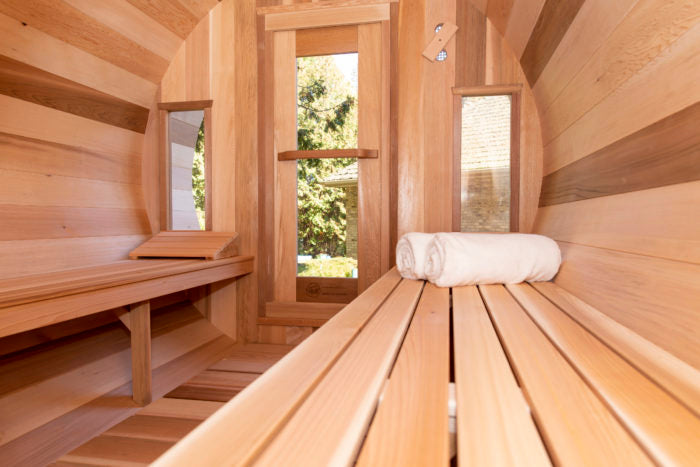Some Of Traditional Sauna
Some Of Traditional Sauna
Blog Article
Fascination About Traditional Sauna
Table of ContentsSome Known Incorrect Statements About Traditional Sauna Traditional Sauna Can Be Fun For EveryoneTraditional Sauna Things To Know Before You Get ThisAll About Traditional SaunaThe Greatest Guide To Traditional Sauna
The majority of the weight lost in a sauna is water loss and is re-gained upon rehydrating. Without an uncertainty sauna can be a vital component of a healthy and balanced weight loss program. To look at the differences between traditional and IR saunas, I will separate these into verifiable, theoretical, and fabricated distinctions.Hence, the hottest point in the saunawhich is at the ceiling directly above the sauna heateris usually between 185 and 190 F. Claims that a conventional sauna surpasses 200 F is just not true and not appropriate for electric saunas sold in the United States. The temperature level for a far-infrared sauna is generally established in between 120 and 140 F; nevertheless, unlike the conventional sauna, the goal in and IR area is not to attain a heat.
Due to this, the temperature level difference is almost irrelevant, given that extreme sweating leads to both sauna kinds, however the method of heating the body is various. In an IR sauna the bather will feel warm and will sweat profusely, yet at much lower temperature levels. Traditional Sauna. Therefore, if the goal is to invest longer durations of time in the sauna, the IR sauna is a good selection

How Traditional Sauna can Save You Time, Stress, and Money.

When the heat is achieved, the elements cycle on and off to preserve the heat. Traditional Sauna. A lot of conventional sauna customers delight in putting water over the rocks to develop vapor to elevate sauna moisture degrees. The advantages of putting water over the rocks consist of: making the area more comfortable, moistening the nasal passages, and allowing the usage of aromatherapy by blending essential oils with the water
In a far-infrared sauna, the warm front penetrate the body to efficiently heat up the body and raise the body core temperature. To achieve this increased temperature, Far-infrared emitters create infrared energy which is close to the same wavelength as that which the body naturally emitsoften described as the "Essential Array" of 7 to 14 microns), so the power is well gotten by the body.
When the power enters the body, it creates the body temperature level to raise and inevitably causes sweat. In an infrared sauna it is necessary for the emitters/heaters to continue to be on virtually frequently. Given that there is no mass of rocks to maintain warm, the sauna will cool if the emitters shut down.
The smart Trick of Traditional Sauna That Nobody is Talking About
As pointed out above, the sauna bather in an infrared area desires to position himself before operating emitters to obtain maximum gain from the warm. The heating time for the 2 rooms can be really different, relying on exactly how the rooms are utilized. For a conventional sauna, a bather needs to click site enable 30-40 mins for the space to attain a preferred temperature level and to correctly pre-heat the rocks.
A well constructed sauna will usually accomplish a temperature level of 150-160 F in concerning 30-40 mins. For hotter temperature levels, the room might require to warm for a longer duration.

Traditional saunas tend to be bigger (therefore make use of even more power) than infrared saunas, although typical saunas are definitely offered in one and two person sizes as well. For a two-person typical sauna, 5x6 or 5x7 dimension is most prominent. The top bench can comfortably seat 2 or three people and is additionally enough time to lie down throughout the sauna session.
Not known Details About Traditional Sauna
The typical cost per kWH of electrical energy in the U.S. is about $0.11 - Traditional Sauna, so a 4.5 kW heating unit will certainly cost about $.50 to run for one hour, if the heating system runs constantly for one hour. his explanation Typically a sauna heating unit will certainly run for 75% of the initial hour and 50% of subsequent hours on considering that the elements cycle once the set temperature level is achieved
A two individual far-infrared room is normally literally smaller than a standard sauna, often regarding 4' x 4' or smaller sized. The IR heating system is normally 1.5-1.7 kW making use of a 120 volt 15 amp plug-in service. Considering that the area can be used faster than a sauna area, we will certainly assume the space is made use of for to of an hour consisting of heat up time.
There is a hardly ever discussed difference in the social experience between the 2 areas. While our society has actually shed some of the social benefit of the conventional sauna experience, it can be extremely anchor socially gratifying. From household time in the sauna, to heart-felt discussions with loved ones, to sauna partiesthe typical sauna experience can lead to intimate socializing.
Some Ideas on Traditional Sauna You Should Know
Many higher end infrared areas include tinted light treatment, sound systems and full-glass fronts.
Report this page